Mental Health Assessment Report: Nursing Practice Analysis
VerifiedAdded on 2023/04/21
|13
|3356
|187
Report
AI Summary
This report presents a comprehensive analysis of a mental health case study, focusing on a 22-year-old client named Annabelle who exhibits severe mental health challenges. The report delves into the identified primary issues, including her withdrawal from social interactions, self-harming behaviors, and auditory hallucinations. It explores the application of the Mental State Examination (MSE) tool to assess Annabelle's condition, examining aspects such as speech, psychomotor behavior, thought patterns, and emotional state. Furthermore, the report outlines intervention strategies based on the WRAP and DREEM approaches, along with the Recovery Star tool, to facilitate Annabelle's recovery. The analysis emphasizes the importance of addressing anxiety, emotional turmoil, and erratic behavior in the care process, aligning with the seven standards of nursing practice to ensure effective interventions, diagnosis, prevention and collaboration.
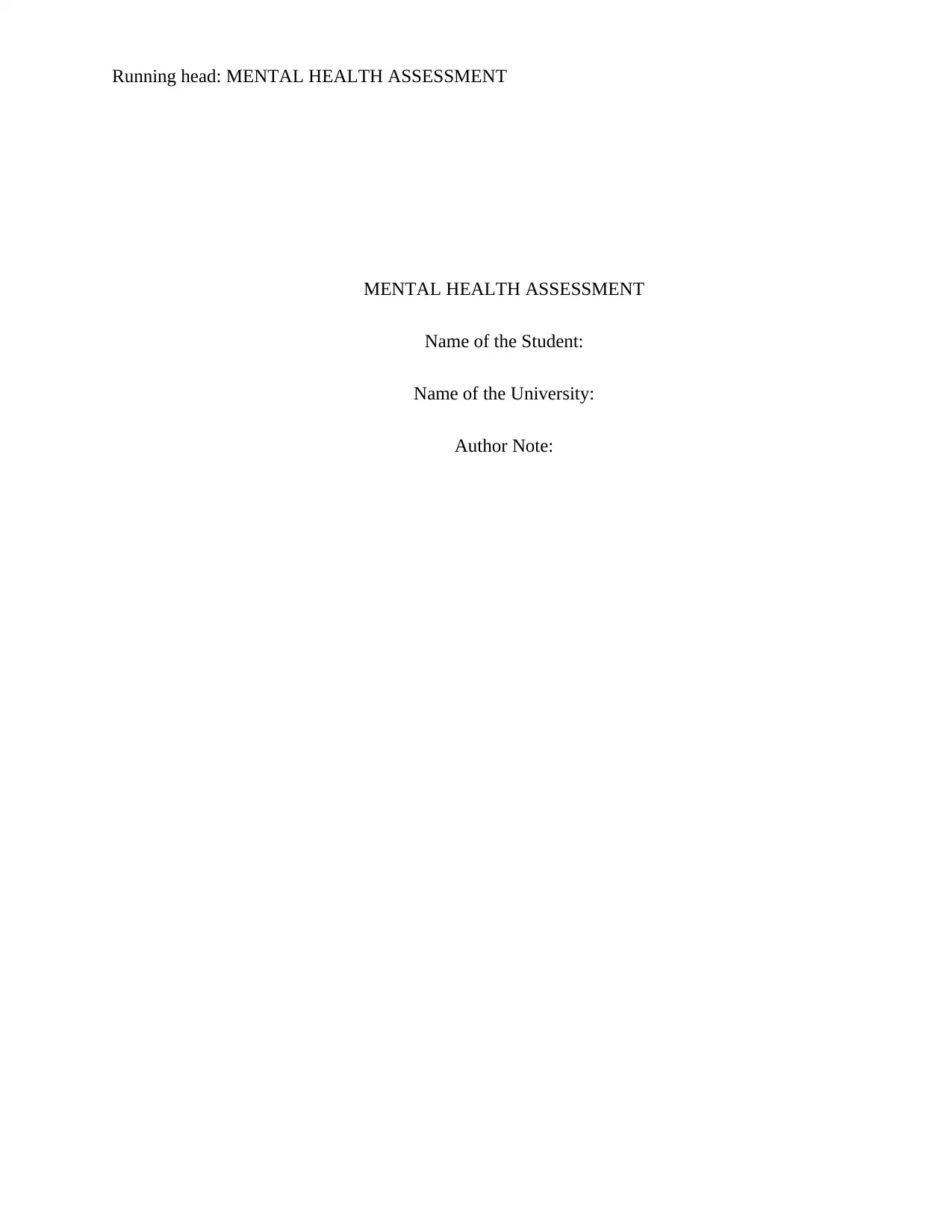
Running head: MENTAL HEALTH ASSESSMENT
MENTAL HEALTH ASSESSMENT
Name of the Student:
Name of the University:
Author Note:
MENTAL HEALTH ASSESSMENT
Name of the Student:
Name of the University:
Author Note:
Paraphrase This Document
Need a fresh take? Get an instant paraphrase of this document with our AI Paraphraser
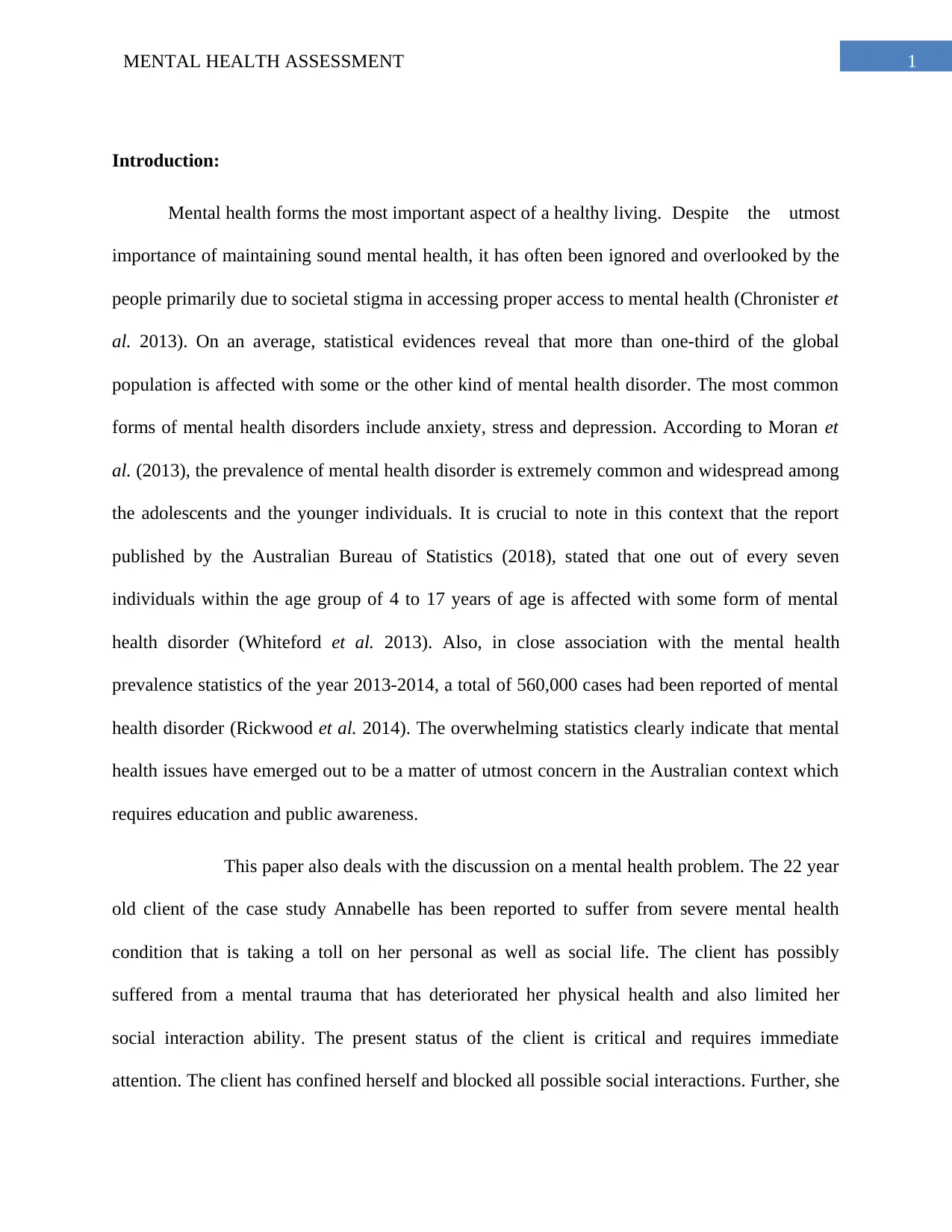
1MENTAL HEALTH ASSESSMENT
Introduction:
Mental health forms the most important aspect of a healthy living. Despite the utmost
importance of maintaining sound mental health, it has often been ignored and overlooked by the
people primarily due to societal stigma in accessing proper access to mental health (Chronister et
al. 2013). On an average, statistical evidences reveal that more than one-third of the global
population is affected with some or the other kind of mental health disorder. The most common
forms of mental health disorders include anxiety, stress and depression. According to Moran et
al. (2013), the prevalence of mental health disorder is extremely common and widespread among
the adolescents and the younger individuals. It is crucial to note in this context that the report
published by the Australian Bureau of Statistics (2018), stated that one out of every seven
individuals within the age group of 4 to 17 years of age is affected with some form of mental
health disorder (Whiteford et al. 2013). Also, in close association with the mental health
prevalence statistics of the year 2013-2014, a total of 560,000 cases had been reported of mental
health disorder (Rickwood et al. 2014). The overwhelming statistics clearly indicate that mental
health issues have emerged out to be a matter of utmost concern in the Australian context which
requires education and public awareness.
This paper also deals with the discussion on a mental health problem. The 22 year
old client of the case study Annabelle has been reported to suffer from severe mental health
condition that is taking a toll on her personal as well as social life. The client has possibly
suffered from a mental trauma that has deteriorated her physical health and also limited her
social interaction ability. The present status of the client is critical and requires immediate
attention. The client has confined herself and blocked all possible social interactions. Further, she
Introduction:
Mental health forms the most important aspect of a healthy living. Despite the utmost
importance of maintaining sound mental health, it has often been ignored and overlooked by the
people primarily due to societal stigma in accessing proper access to mental health (Chronister et
al. 2013). On an average, statistical evidences reveal that more than one-third of the global
population is affected with some or the other kind of mental health disorder. The most common
forms of mental health disorders include anxiety, stress and depression. According to Moran et
al. (2013), the prevalence of mental health disorder is extremely common and widespread among
the adolescents and the younger individuals. It is crucial to note in this context that the report
published by the Australian Bureau of Statistics (2018), stated that one out of every seven
individuals within the age group of 4 to 17 years of age is affected with some form of mental
health disorder (Whiteford et al. 2013). Also, in close association with the mental health
prevalence statistics of the year 2013-2014, a total of 560,000 cases had been reported of mental
health disorder (Rickwood et al. 2014). The overwhelming statistics clearly indicate that mental
health issues have emerged out to be a matter of utmost concern in the Australian context which
requires education and public awareness.
This paper also deals with the discussion on a mental health problem. The 22 year
old client of the case study Annabelle has been reported to suffer from severe mental health
condition that is taking a toll on her personal as well as social life. The client has possibly
suffered from a mental trauma that has deteriorated her physical health and also limited her
social interaction ability. The present status of the client is critical and requires immediate
attention. The client has confined herself and blocked all possible social interactions. Further, she
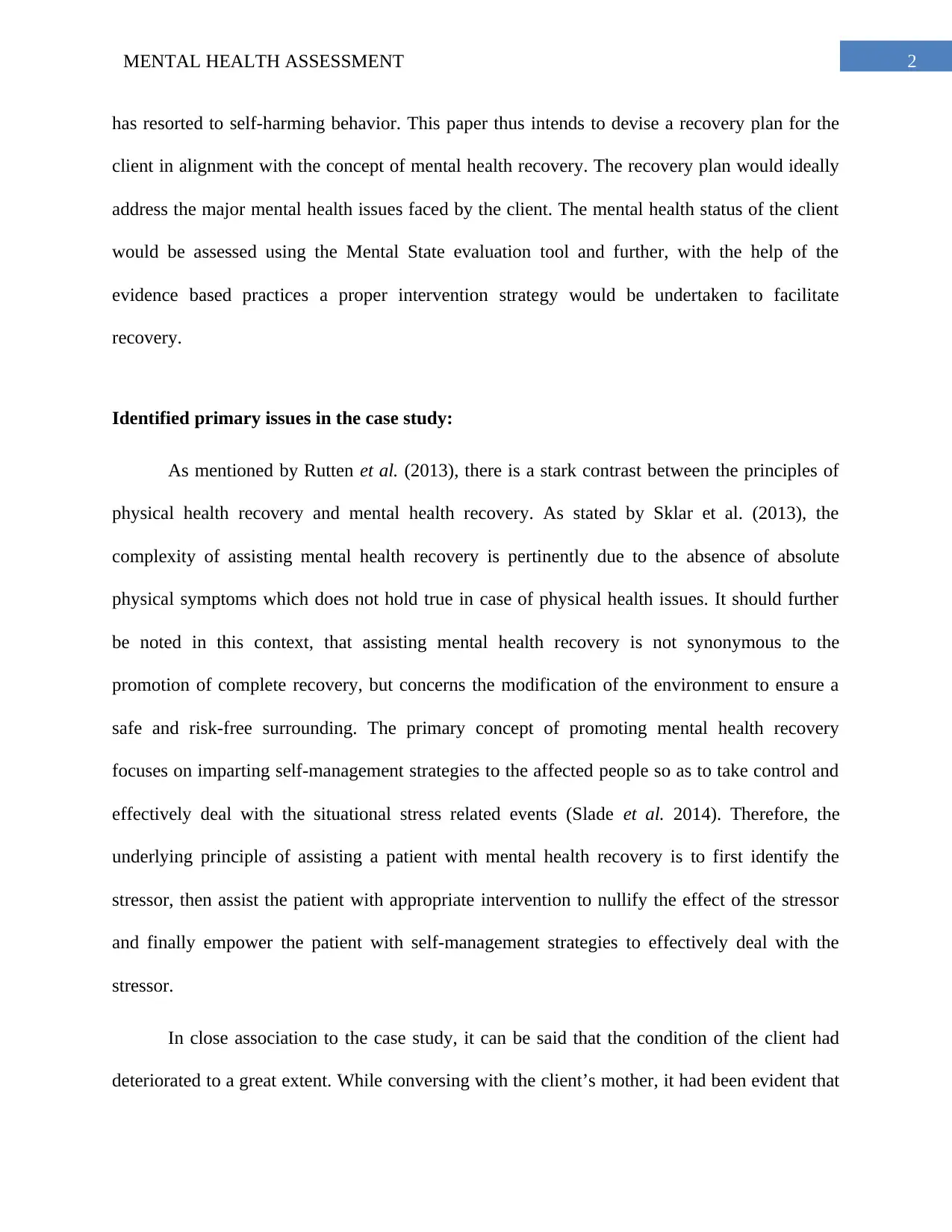
2MENTAL HEALTH ASSESSMENT
has resorted to self-harming behavior. This paper thus intends to devise a recovery plan for the
client in alignment with the concept of mental health recovery. The recovery plan would ideally
address the major mental health issues faced by the client. The mental health status of the client
would be assessed using the Mental State evaluation tool and further, with the help of the
evidence based practices a proper intervention strategy would be undertaken to facilitate
recovery.
Identified primary issues in the case study:
As mentioned by Rutten et al. (2013), there is a stark contrast between the principles of
physical health recovery and mental health recovery. As stated by Sklar et al. (2013), the
complexity of assisting mental health recovery is pertinently due to the absence of absolute
physical symptoms which does not hold true in case of physical health issues. It should further
be noted in this context, that assisting mental health recovery is not synonymous to the
promotion of complete recovery, but concerns the modification of the environment to ensure a
safe and risk-free surrounding. The primary concept of promoting mental health recovery
focuses on imparting self-management strategies to the affected people so as to take control and
effectively deal with the situational stress related events (Slade et al. 2014). Therefore, the
underlying principle of assisting a patient with mental health recovery is to first identify the
stressor, then assist the patient with appropriate intervention to nullify the effect of the stressor
and finally empower the patient with self-management strategies to effectively deal with the
stressor.
In close association to the case study, it can be said that the condition of the client had
deteriorated to a great extent. While conversing with the client’s mother, it had been evident that
has resorted to self-harming behavior. This paper thus intends to devise a recovery plan for the
client in alignment with the concept of mental health recovery. The recovery plan would ideally
address the major mental health issues faced by the client. The mental health status of the client
would be assessed using the Mental State evaluation tool and further, with the help of the
evidence based practices a proper intervention strategy would be undertaken to facilitate
recovery.
Identified primary issues in the case study:
As mentioned by Rutten et al. (2013), there is a stark contrast between the principles of
physical health recovery and mental health recovery. As stated by Sklar et al. (2013), the
complexity of assisting mental health recovery is pertinently due to the absence of absolute
physical symptoms which does not hold true in case of physical health issues. It should further
be noted in this context, that assisting mental health recovery is not synonymous to the
promotion of complete recovery, but concerns the modification of the environment to ensure a
safe and risk-free surrounding. The primary concept of promoting mental health recovery
focuses on imparting self-management strategies to the affected people so as to take control and
effectively deal with the situational stress related events (Slade et al. 2014). Therefore, the
underlying principle of assisting a patient with mental health recovery is to first identify the
stressor, then assist the patient with appropriate intervention to nullify the effect of the stressor
and finally empower the patient with self-management strategies to effectively deal with the
stressor.
In close association to the case study, it can be said that the condition of the client had
deteriorated to a great extent. While conversing with the client’s mother, it had been evident that
⊘ This is a preview!⊘
Do you want full access?
Subscribe today to unlock all pages.

Trusted by 1+ million students worldwide
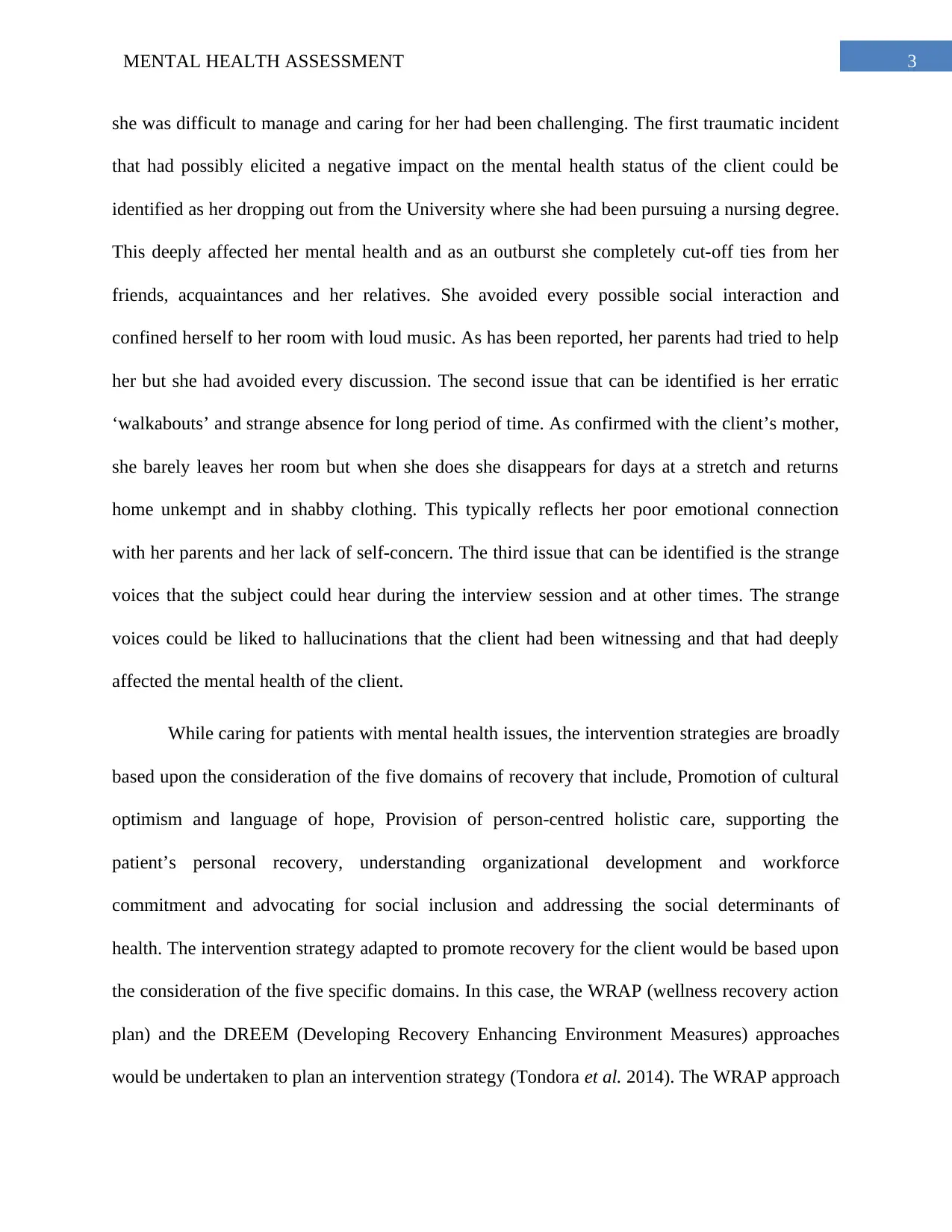
3MENTAL HEALTH ASSESSMENT
she was difficult to manage and caring for her had been challenging. The first traumatic incident
that had possibly elicited a negative impact on the mental health status of the client could be
identified as her dropping out from the University where she had been pursuing a nursing degree.
This deeply affected her mental health and as an outburst she completely cut-off ties from her
friends, acquaintances and her relatives. She avoided every possible social interaction and
confined herself to her room with loud music. As has been reported, her parents had tried to help
her but she had avoided every discussion. The second issue that can be identified is her erratic
‘walkabouts’ and strange absence for long period of time. As confirmed with the client’s mother,
she barely leaves her room but when she does she disappears for days at a stretch and returns
home unkempt and in shabby clothing. This typically reflects her poor emotional connection
with her parents and her lack of self-concern. The third issue that can be identified is the strange
voices that the subject could hear during the interview session and at other times. The strange
voices could be liked to hallucinations that the client had been witnessing and that had deeply
affected the mental health of the client.
While caring for patients with mental health issues, the intervention strategies are broadly
based upon the consideration of the five domains of recovery that include, Promotion of cultural
optimism and language of hope, Provision of person-centred holistic care, supporting the
patient’s personal recovery, understanding organizational development and workforce
commitment and advocating for social inclusion and addressing the social determinants of
health. The intervention strategy adapted to promote recovery for the client would be based upon
the consideration of the five specific domains. In this case, the WRAP (wellness recovery action
plan) and the DREEM (Developing Recovery Enhancing Environment Measures) approaches
would be undertaken to plan an intervention strategy (Tondora et al. 2014). The WRAP approach
she was difficult to manage and caring for her had been challenging. The first traumatic incident
that had possibly elicited a negative impact on the mental health status of the client could be
identified as her dropping out from the University where she had been pursuing a nursing degree.
This deeply affected her mental health and as an outburst she completely cut-off ties from her
friends, acquaintances and her relatives. She avoided every possible social interaction and
confined herself to her room with loud music. As has been reported, her parents had tried to help
her but she had avoided every discussion. The second issue that can be identified is her erratic
‘walkabouts’ and strange absence for long period of time. As confirmed with the client’s mother,
she barely leaves her room but when she does she disappears for days at a stretch and returns
home unkempt and in shabby clothing. This typically reflects her poor emotional connection
with her parents and her lack of self-concern. The third issue that can be identified is the strange
voices that the subject could hear during the interview session and at other times. The strange
voices could be liked to hallucinations that the client had been witnessing and that had deeply
affected the mental health of the client.
While caring for patients with mental health issues, the intervention strategies are broadly
based upon the consideration of the five domains of recovery that include, Promotion of cultural
optimism and language of hope, Provision of person-centred holistic care, supporting the
patient’s personal recovery, understanding organizational development and workforce
commitment and advocating for social inclusion and addressing the social determinants of
health. The intervention strategy adapted to promote recovery for the client would be based upon
the consideration of the five specific domains. In this case, the WRAP (wellness recovery action
plan) and the DREEM (Developing Recovery Enhancing Environment Measures) approaches
would be undertaken to plan an intervention strategy (Tondora et al. 2014). The WRAP approach
Paraphrase This Document
Need a fresh take? Get an instant paraphrase of this document with our AI Paraphraser
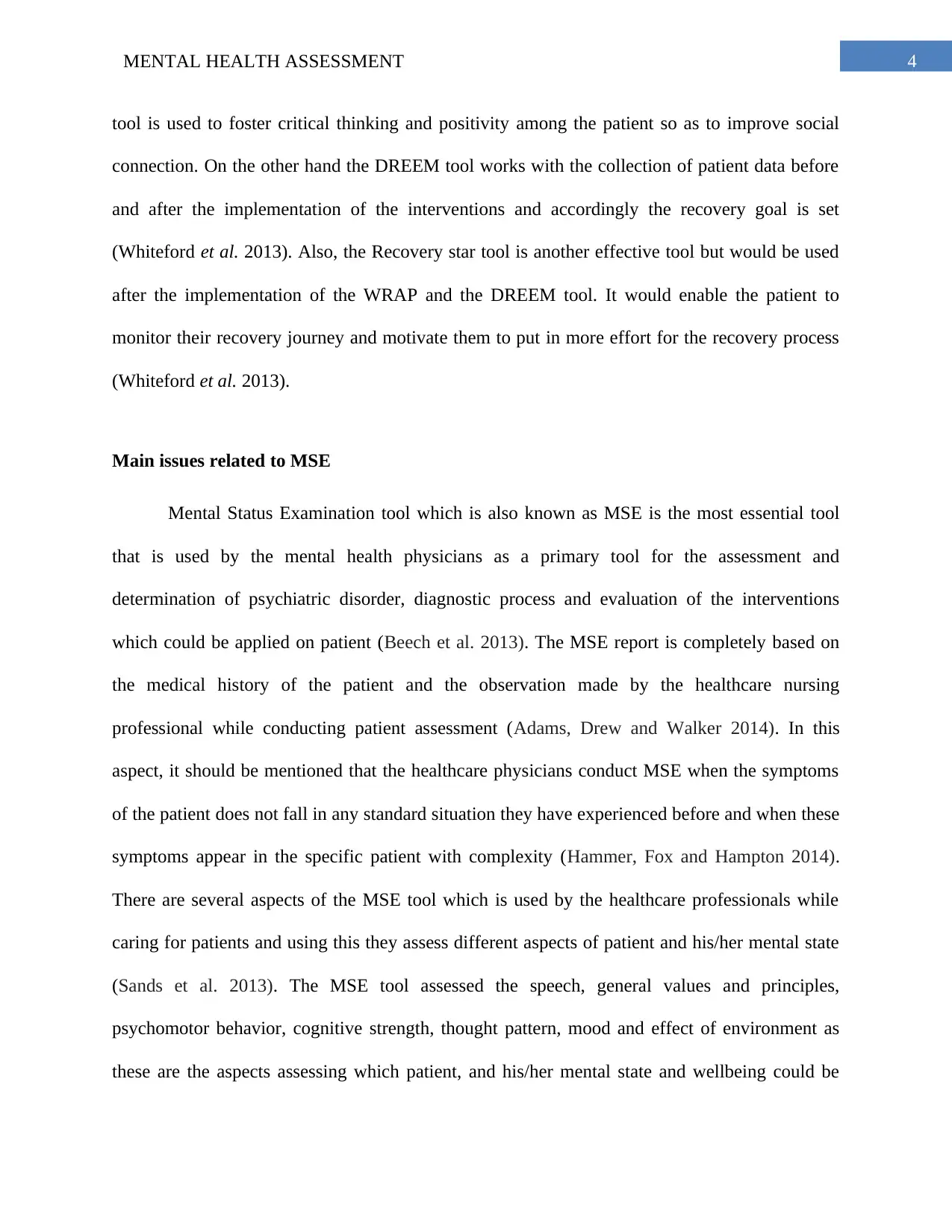
4MENTAL HEALTH ASSESSMENT
tool is used to foster critical thinking and positivity among the patient so as to improve social
connection. On the other hand the DREEM tool works with the collection of patient data before
and after the implementation of the interventions and accordingly the recovery goal is set
(Whiteford et al. 2013). Also, the Recovery star tool is another effective tool but would be used
after the implementation of the WRAP and the DREEM tool. It would enable the patient to
monitor their recovery journey and motivate them to put in more effort for the recovery process
(Whiteford et al. 2013).
Main issues related to MSE
Mental Status Examination tool which is also known as MSE is the most essential tool
that is used by the mental health physicians as a primary tool for the assessment and
determination of psychiatric disorder, diagnostic process and evaluation of the interventions
which could be applied on patient (Beech et al. 2013). The MSE report is completely based on
the medical history of the patient and the observation made by the healthcare nursing
professional while conducting patient assessment (Adams, Drew and Walker 2014). In this
aspect, it should be mentioned that the healthcare physicians conduct MSE when the symptoms
of the patient does not fall in any standard situation they have experienced before and when these
symptoms appear in the specific patient with complexity (Hammer, Fox and Hampton 2014).
There are several aspects of the MSE tool which is used by the healthcare professionals while
caring for patients and using this they assess different aspects of patient and his/her mental state
(Sands et al. 2013). The MSE tool assessed the speech, general values and principles,
psychomotor behavior, cognitive strength, thought pattern, mood and effect of environment as
these are the aspects assessing which patient, and his/her mental state and wellbeing could be
tool is used to foster critical thinking and positivity among the patient so as to improve social
connection. On the other hand the DREEM tool works with the collection of patient data before
and after the implementation of the interventions and accordingly the recovery goal is set
(Whiteford et al. 2013). Also, the Recovery star tool is another effective tool but would be used
after the implementation of the WRAP and the DREEM tool. It would enable the patient to
monitor their recovery journey and motivate them to put in more effort for the recovery process
(Whiteford et al. 2013).
Main issues related to MSE
Mental Status Examination tool which is also known as MSE is the most essential tool
that is used by the mental health physicians as a primary tool for the assessment and
determination of psychiatric disorder, diagnostic process and evaluation of the interventions
which could be applied on patient (Beech et al. 2013). The MSE report is completely based on
the medical history of the patient and the observation made by the healthcare nursing
professional while conducting patient assessment (Adams, Drew and Walker 2014). In this
aspect, it should be mentioned that the healthcare physicians conduct MSE when the symptoms
of the patient does not fall in any standard situation they have experienced before and when these
symptoms appear in the specific patient with complexity (Hammer, Fox and Hampton 2014).
There are several aspects of the MSE tool which is used by the healthcare professionals while
caring for patients and using this they assess different aspects of patient and his/her mental state
(Sands et al. 2013). The MSE tool assessed the speech, general values and principles,
psychomotor behavior, cognitive strength, thought pattern, mood and effect of environment as
these are the aspects assessing which patient, and his/her mental state and wellbeing could be
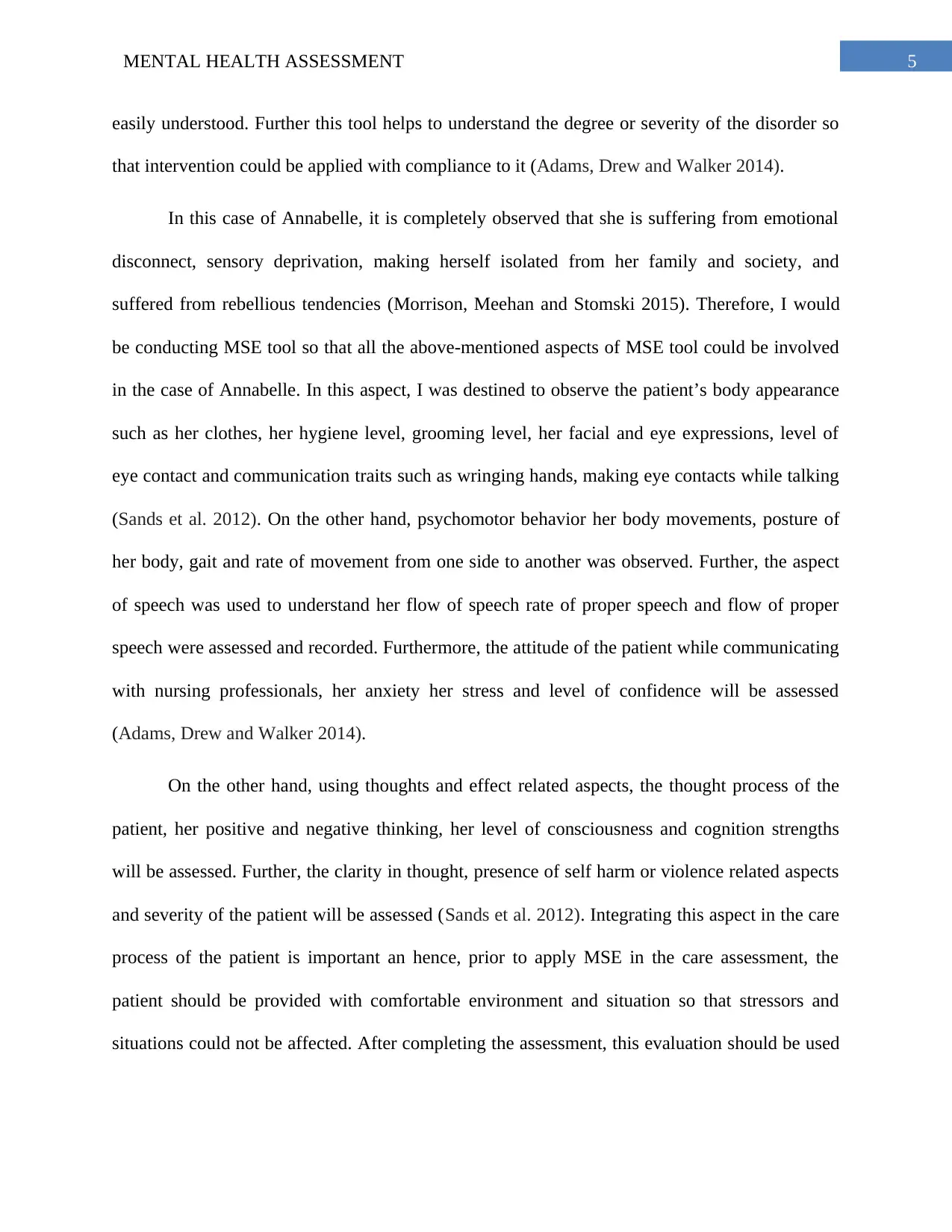
5MENTAL HEALTH ASSESSMENT
easily understood. Further this tool helps to understand the degree or severity of the disorder so
that intervention could be applied with compliance to it (Adams, Drew and Walker 2014).
In this case of Annabelle, it is completely observed that she is suffering from emotional
disconnect, sensory deprivation, making herself isolated from her family and society, and
suffered from rebellious tendencies (Morrison, Meehan and Stomski 2015). Therefore, I would
be conducting MSE tool so that all the above-mentioned aspects of MSE tool could be involved
in the case of Annabelle. In this aspect, I was destined to observe the patient’s body appearance
such as her clothes, her hygiene level, grooming level, her facial and eye expressions, level of
eye contact and communication traits such as wringing hands, making eye contacts while talking
(Sands et al. 2012). On the other hand, psychomotor behavior her body movements, posture of
her body, gait and rate of movement from one side to another was observed. Further, the aspect
of speech was used to understand her flow of speech rate of proper speech and flow of proper
speech were assessed and recorded. Furthermore, the attitude of the patient while communicating
with nursing professionals, her anxiety her stress and level of confidence will be assessed
(Adams, Drew and Walker 2014).
On the other hand, using thoughts and effect related aspects, the thought process of the
patient, her positive and negative thinking, her level of consciousness and cognition strengths
will be assessed. Further, the clarity in thought, presence of self harm or violence related aspects
and severity of the patient will be assessed (Sands et al. 2012). Integrating this aspect in the care
process of the patient is important an hence, prior to apply MSE in the care assessment, the
patient should be provided with comfortable environment and situation so that stressors and
situations could not be affected. After completing the assessment, this evaluation should be used
easily understood. Further this tool helps to understand the degree or severity of the disorder so
that intervention could be applied with compliance to it (Adams, Drew and Walker 2014).
In this case of Annabelle, it is completely observed that she is suffering from emotional
disconnect, sensory deprivation, making herself isolated from her family and society, and
suffered from rebellious tendencies (Morrison, Meehan and Stomski 2015). Therefore, I would
be conducting MSE tool so that all the above-mentioned aspects of MSE tool could be involved
in the case of Annabelle. In this aspect, I was destined to observe the patient’s body appearance
such as her clothes, her hygiene level, grooming level, her facial and eye expressions, level of
eye contact and communication traits such as wringing hands, making eye contacts while talking
(Sands et al. 2012). On the other hand, psychomotor behavior her body movements, posture of
her body, gait and rate of movement from one side to another was observed. Further, the aspect
of speech was used to understand her flow of speech rate of proper speech and flow of proper
speech were assessed and recorded. Furthermore, the attitude of the patient while communicating
with nursing professionals, her anxiety her stress and level of confidence will be assessed
(Adams, Drew and Walker 2014).
On the other hand, using thoughts and effect related aspects, the thought process of the
patient, her positive and negative thinking, her level of consciousness and cognition strengths
will be assessed. Further, the clarity in thought, presence of self harm or violence related aspects
and severity of the patient will be assessed (Sands et al. 2012). Integrating this aspect in the care
process of the patient is important an hence, prior to apply MSE in the care assessment, the
patient should be provided with comfortable environment and situation so that stressors and
situations could not be affected. After completing the assessment, this evaluation should be used
⊘ This is a preview!⊘
Do you want full access?
Subscribe today to unlock all pages.

Trusted by 1+ million students worldwide
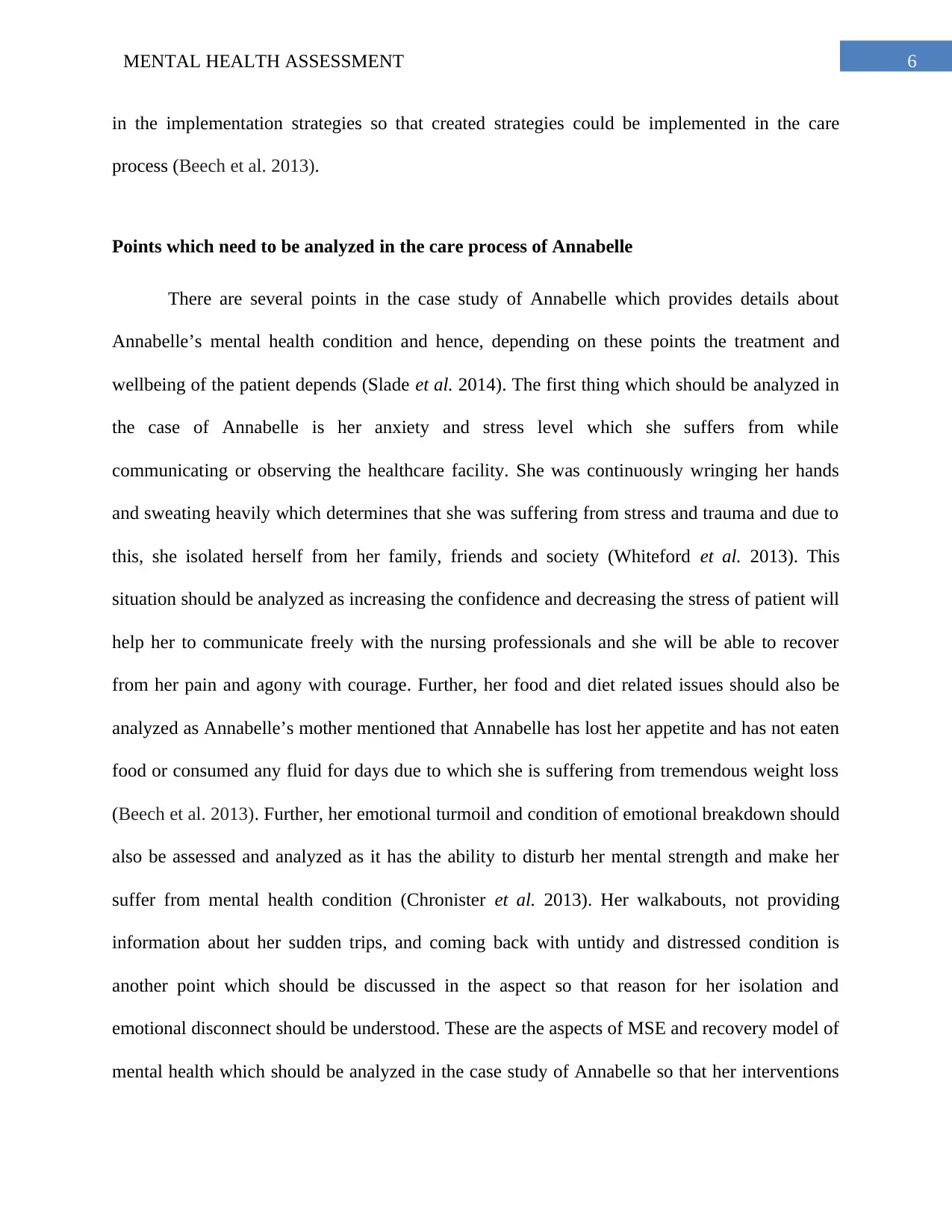
6MENTAL HEALTH ASSESSMENT
in the implementation strategies so that created strategies could be implemented in the care
process (Beech et al. 2013).
Points which need to be analyzed in the care process of Annabelle
There are several points in the case study of Annabelle which provides details about
Annabelle’s mental health condition and hence, depending on these points the treatment and
wellbeing of the patient depends (Slade et al. 2014). The first thing which should be analyzed in
the case of Annabelle is her anxiety and stress level which she suffers from while
communicating or observing the healthcare facility. She was continuously wringing her hands
and sweating heavily which determines that she was suffering from stress and trauma and due to
this, she isolated herself from her family, friends and society (Whiteford et al. 2013). This
situation should be analyzed as increasing the confidence and decreasing the stress of patient will
help her to communicate freely with the nursing professionals and she will be able to recover
from her pain and agony with courage. Further, her food and diet related issues should also be
analyzed as Annabelle’s mother mentioned that Annabelle has lost her appetite and has not eaten
food or consumed any fluid for days due to which she is suffering from tremendous weight loss
(Beech et al. 2013). Further, her emotional turmoil and condition of emotional breakdown should
also be assessed and analyzed as it has the ability to disturb her mental strength and make her
suffer from mental health condition (Chronister et al. 2013). Her walkabouts, not providing
information about her sudden trips, and coming back with untidy and distressed condition is
another point which should be discussed in the aspect so that reason for her isolation and
emotional disconnect should be understood. These are the aspects of MSE and recovery model of
mental health which should be analyzed in the case study of Annabelle so that her interventions
in the implementation strategies so that created strategies could be implemented in the care
process (Beech et al. 2013).
Points which need to be analyzed in the care process of Annabelle
There are several points in the case study of Annabelle which provides details about
Annabelle’s mental health condition and hence, depending on these points the treatment and
wellbeing of the patient depends (Slade et al. 2014). The first thing which should be analyzed in
the case of Annabelle is her anxiety and stress level which she suffers from while
communicating or observing the healthcare facility. She was continuously wringing her hands
and sweating heavily which determines that she was suffering from stress and trauma and due to
this, she isolated herself from her family, friends and society (Whiteford et al. 2013). This
situation should be analyzed as increasing the confidence and decreasing the stress of patient will
help her to communicate freely with the nursing professionals and she will be able to recover
from her pain and agony with courage. Further, her food and diet related issues should also be
analyzed as Annabelle’s mother mentioned that Annabelle has lost her appetite and has not eaten
food or consumed any fluid for days due to which she is suffering from tremendous weight loss
(Beech et al. 2013). Further, her emotional turmoil and condition of emotional breakdown should
also be assessed and analyzed as it has the ability to disturb her mental strength and make her
suffer from mental health condition (Chronister et al. 2013). Her walkabouts, not providing
information about her sudden trips, and coming back with untidy and distressed condition is
another point which should be discussed in the aspect so that reason for her isolation and
emotional disconnect should be understood. These are the aspects of MSE and recovery model of
mental health which should be analyzed in the case study of Annabelle so that her interventions
Paraphrase This Document
Need a fresh take? Get an instant paraphrase of this document with our AI Paraphraser
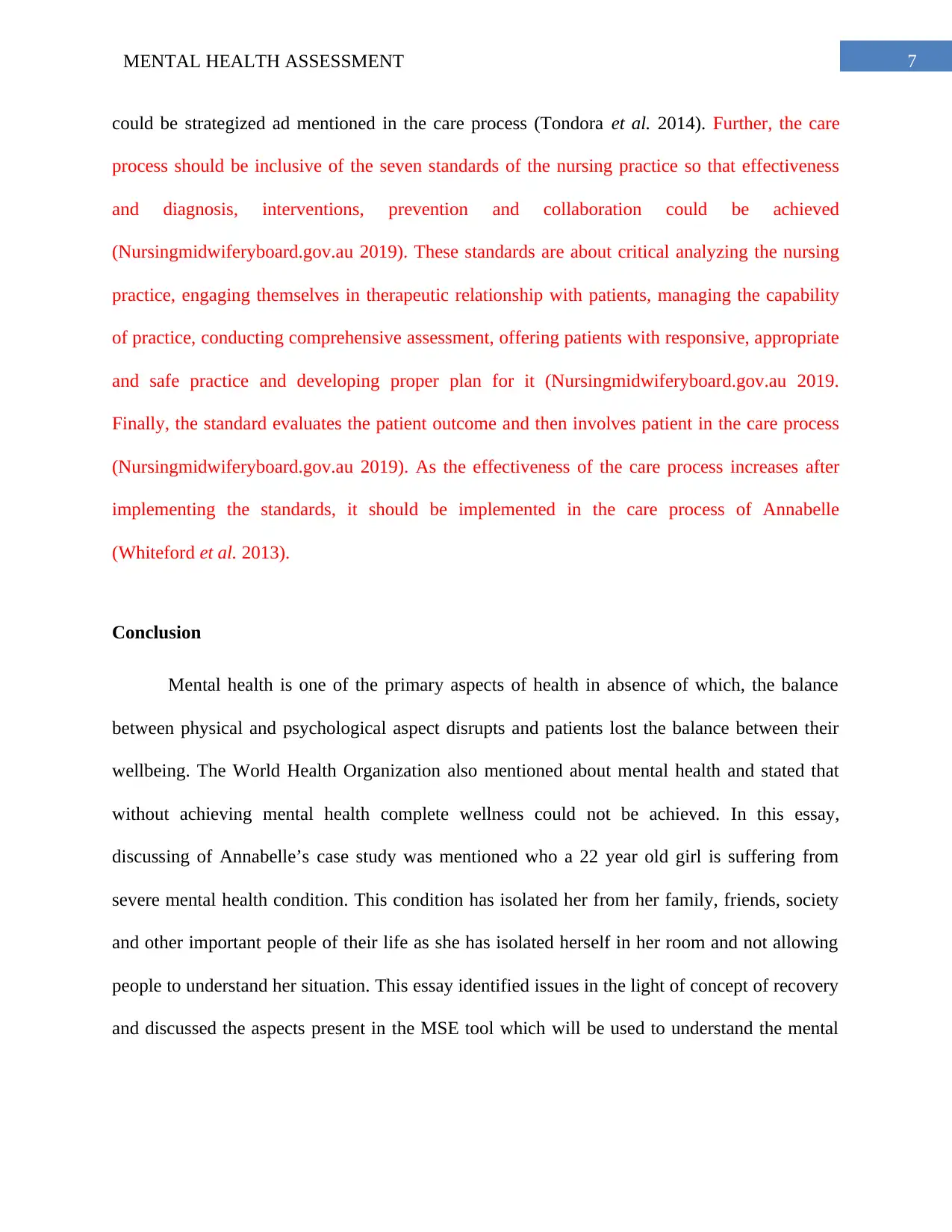
7MENTAL HEALTH ASSESSMENT
could be strategized ad mentioned in the care process (Tondora et al. 2014). Further, the care
process should be inclusive of the seven standards of the nursing practice so that effectiveness
and diagnosis, interventions, prevention and collaboration could be achieved
(Nursingmidwiferyboard.gov.au 2019). These standards are about critical analyzing the nursing
practice, engaging themselves in therapeutic relationship with patients, managing the capability
of practice, conducting comprehensive assessment, offering patients with responsive, appropriate
and safe practice and developing proper plan for it (Nursingmidwiferyboard.gov.au 2019.
Finally, the standard evaluates the patient outcome and then involves patient in the care process
(Nursingmidwiferyboard.gov.au 2019). As the effectiveness of the care process increases after
implementing the standards, it should be implemented in the care process of Annabelle
(Whiteford et al. 2013).
Conclusion
Mental health is one of the primary aspects of health in absence of which, the balance
between physical and psychological aspect disrupts and patients lost the balance between their
wellbeing. The World Health Organization also mentioned about mental health and stated that
without achieving mental health complete wellness could not be achieved. In this essay,
discussing of Annabelle’s case study was mentioned who a 22 year old girl is suffering from
severe mental health condition. This condition has isolated her from her family, friends, society
and other important people of their life as she has isolated herself in her room and not allowing
people to understand her situation. This essay identified issues in the light of concept of recovery
and discussed the aspects present in the MSE tool which will be used to understand the mental
could be strategized ad mentioned in the care process (Tondora et al. 2014). Further, the care
process should be inclusive of the seven standards of the nursing practice so that effectiveness
and diagnosis, interventions, prevention and collaboration could be achieved
(Nursingmidwiferyboard.gov.au 2019). These standards are about critical analyzing the nursing
practice, engaging themselves in therapeutic relationship with patients, managing the capability
of practice, conducting comprehensive assessment, offering patients with responsive, appropriate
and safe practice and developing proper plan for it (Nursingmidwiferyboard.gov.au 2019.
Finally, the standard evaluates the patient outcome and then involves patient in the care process
(Nursingmidwiferyboard.gov.au 2019). As the effectiveness of the care process increases after
implementing the standards, it should be implemented in the care process of Annabelle
(Whiteford et al. 2013).
Conclusion
Mental health is one of the primary aspects of health in absence of which, the balance
between physical and psychological aspect disrupts and patients lost the balance between their
wellbeing. The World Health Organization also mentioned about mental health and stated that
without achieving mental health complete wellness could not be achieved. In this essay,
discussing of Annabelle’s case study was mentioned who a 22 year old girl is suffering from
severe mental health condition. This condition has isolated her from her family, friends, society
and other important people of their life as she has isolated herself in her room and not allowing
people to understand her situation. This essay identified issues in the light of concept of recovery
and discussed the aspects present in the MSE tool which will be used to understand the mental
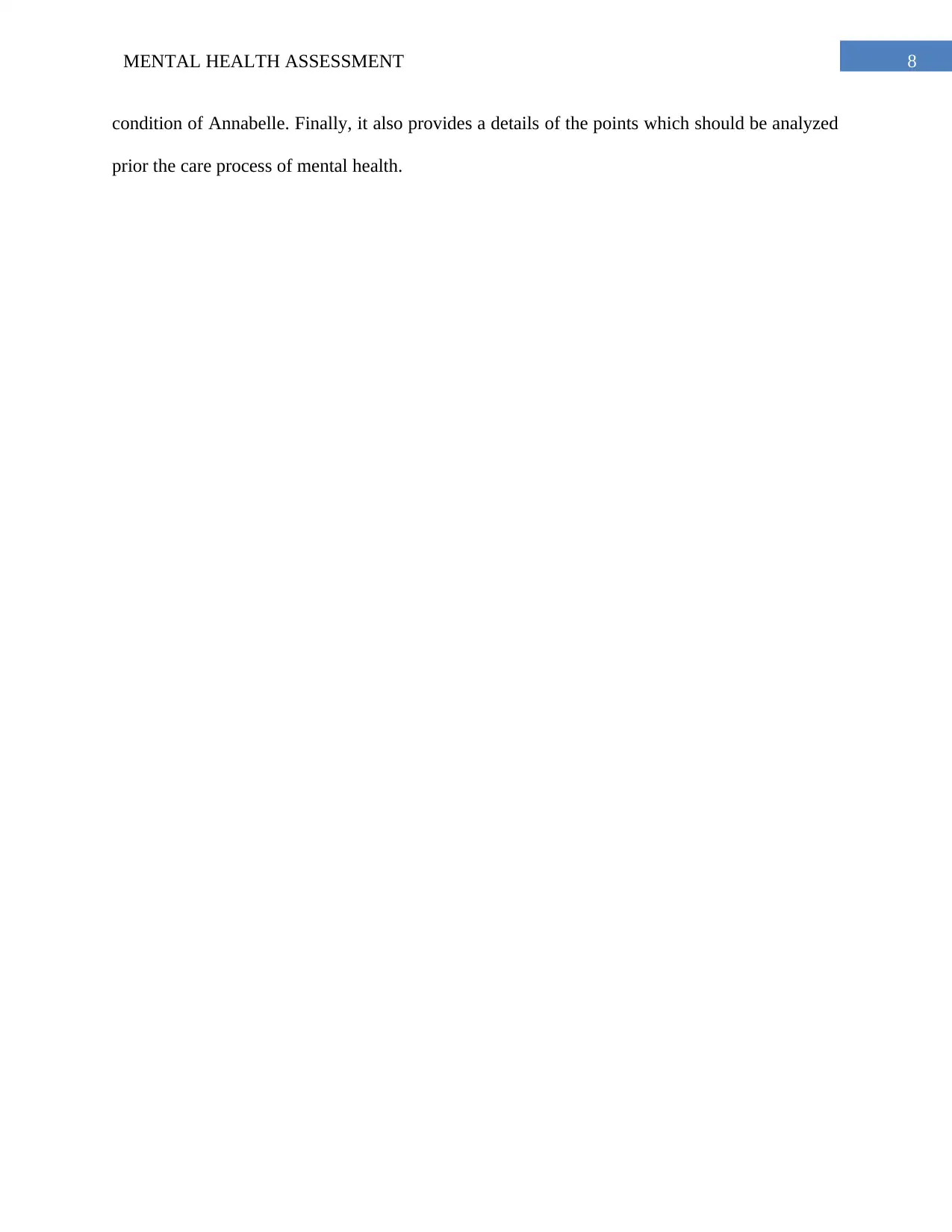
8MENTAL HEALTH ASSESSMENT
condition of Annabelle. Finally, it also provides a details of the points which should be analyzed
prior the care process of mental health.
condition of Annabelle. Finally, it also provides a details of the points which should be analyzed
prior the care process of mental health.
⊘ This is a preview!⊘
Do you want full access?
Subscribe today to unlock all pages.

Trusted by 1+ million students worldwide
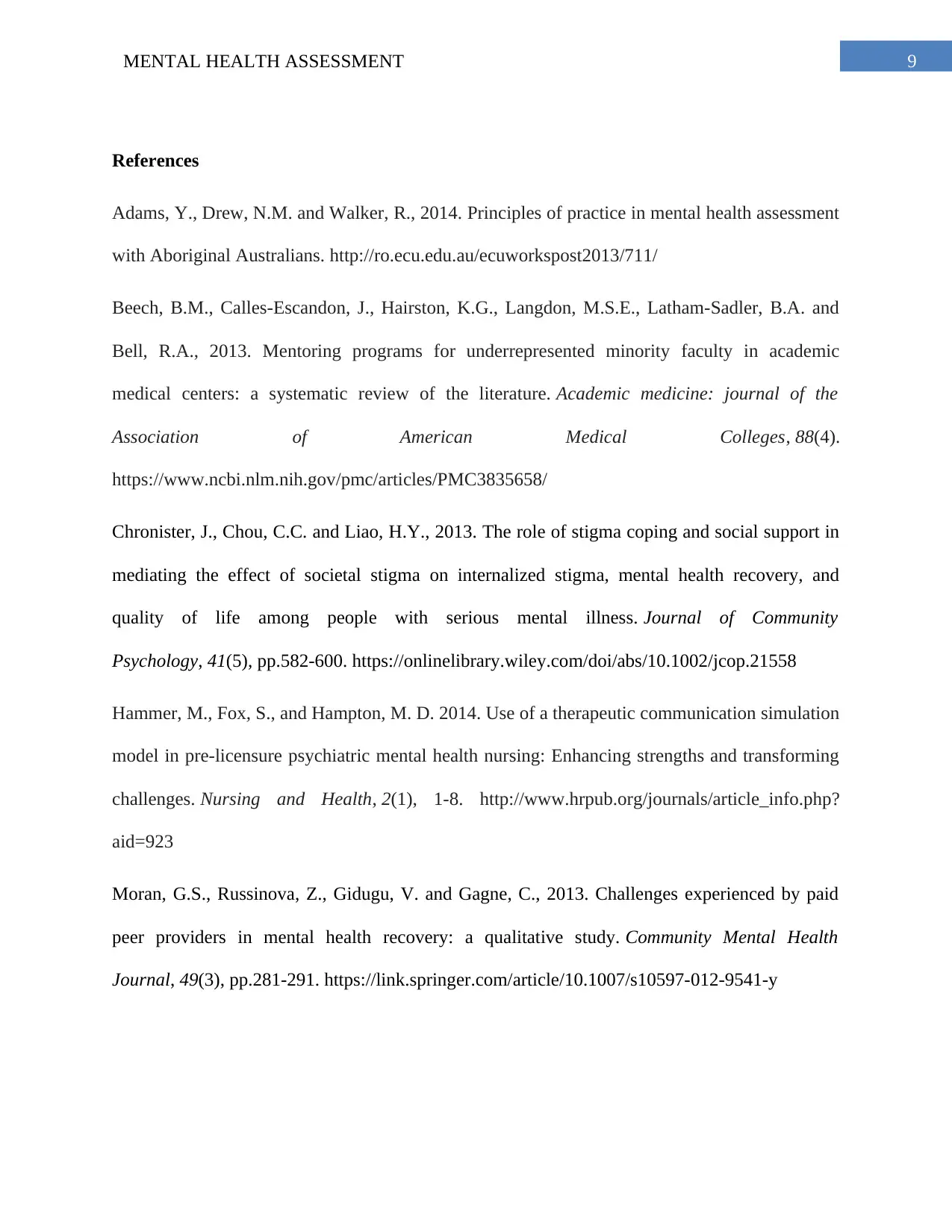
9MENTAL HEALTH ASSESSMENT
References
Adams, Y., Drew, N.M. and Walker, R., 2014. Principles of practice in mental health assessment
with Aboriginal Australians. http://ro.ecu.edu.au/ecuworkspost2013/711/
Beech, B.M., Calles-Escandon, J., Hairston, K.G., Langdon, M.S.E., Latham-Sadler, B.A. and
Bell, R.A., 2013. Mentoring programs for underrepresented minority faculty in academic
medical centers: a systematic review of the literature. Academic medicine: journal of the
Association of American Medical Colleges, 88(4).
https://www.ncbi.nlm.nih.gov/pmc/articles/PMC3835658/
Chronister, J., Chou, C.C. and Liao, H.Y., 2013. The role of stigma coping and social support in
mediating the effect of societal stigma on internalized stigma, mental health recovery, and
quality of life among people with serious mental illness. Journal of Community
Psychology, 41(5), pp.582-600. https://onlinelibrary.wiley.com/doi/abs/10.1002/jcop.21558
Hammer, M., Fox, S., and Hampton, M. D. 2014. Use of a therapeutic communication simulation
model in pre-licensure psychiatric mental health nursing: Enhancing strengths and transforming
challenges. Nursing and Health, 2(1), 1-8. http://www.hrpub.org/journals/article_info.php?
aid=923
Moran, G.S., Russinova, Z., Gidugu, V. and Gagne, C., 2013. Challenges experienced by paid
peer providers in mental health recovery: a qualitative study. Community Mental Health
Journal, 49(3), pp.281-291. https://link.springer.com/article/10.1007/s10597-012-9541-y
References
Adams, Y., Drew, N.M. and Walker, R., 2014. Principles of practice in mental health assessment
with Aboriginal Australians. http://ro.ecu.edu.au/ecuworkspost2013/711/
Beech, B.M., Calles-Escandon, J., Hairston, K.G., Langdon, M.S.E., Latham-Sadler, B.A. and
Bell, R.A., 2013. Mentoring programs for underrepresented minority faculty in academic
medical centers: a systematic review of the literature. Academic medicine: journal of the
Association of American Medical Colleges, 88(4).
https://www.ncbi.nlm.nih.gov/pmc/articles/PMC3835658/
Chronister, J., Chou, C.C. and Liao, H.Y., 2013. The role of stigma coping and social support in
mediating the effect of societal stigma on internalized stigma, mental health recovery, and
quality of life among people with serious mental illness. Journal of Community
Psychology, 41(5), pp.582-600. https://onlinelibrary.wiley.com/doi/abs/10.1002/jcop.21558
Hammer, M., Fox, S., and Hampton, M. D. 2014. Use of a therapeutic communication simulation
model in pre-licensure psychiatric mental health nursing: Enhancing strengths and transforming
challenges. Nursing and Health, 2(1), 1-8. http://www.hrpub.org/journals/article_info.php?
aid=923
Moran, G.S., Russinova, Z., Gidugu, V. and Gagne, C., 2013. Challenges experienced by paid
peer providers in mental health recovery: a qualitative study. Community Mental Health
Journal, 49(3), pp.281-291. https://link.springer.com/article/10.1007/s10597-012-9541-y
Paraphrase This Document
Need a fresh take? Get an instant paraphrase of this document with our AI Paraphraser
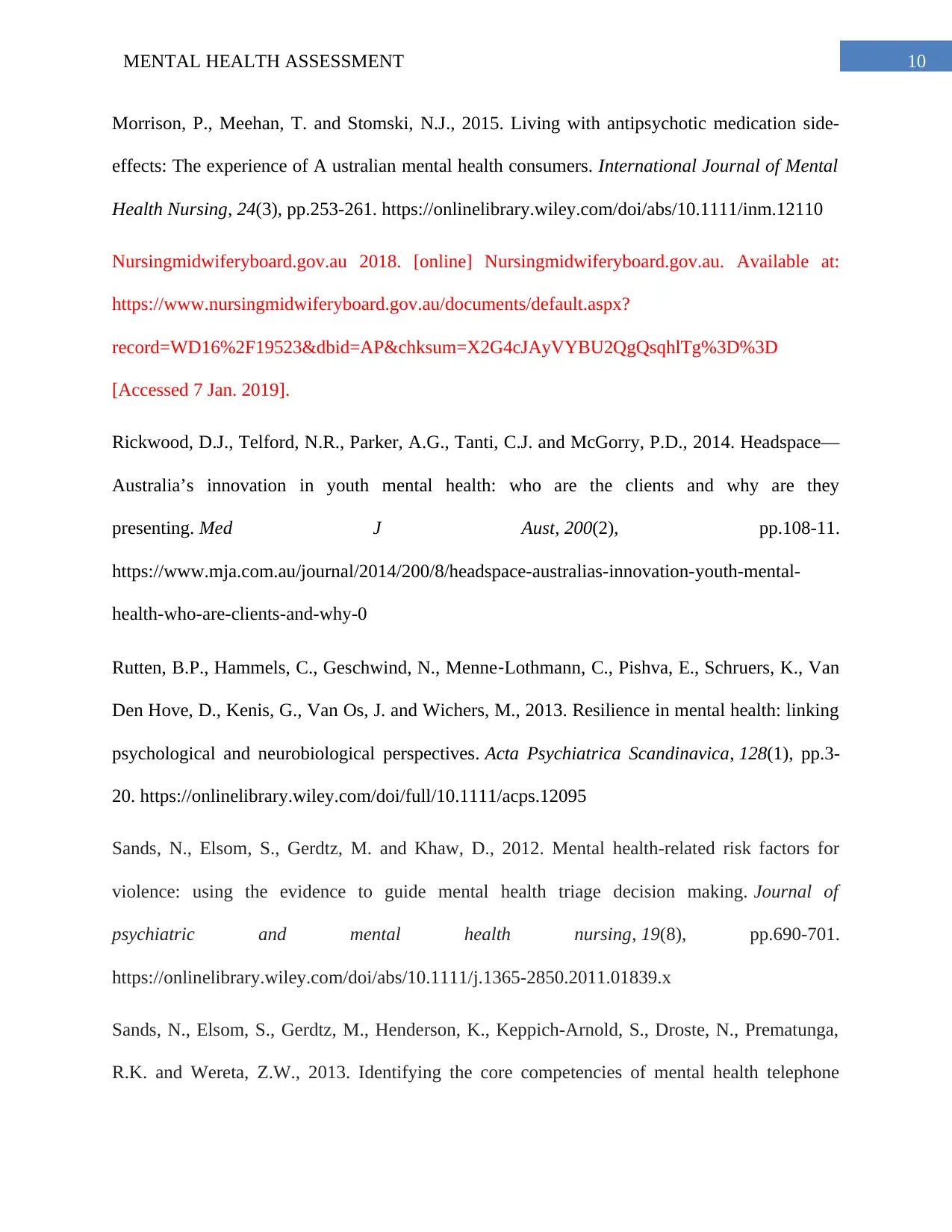
10MENTAL HEALTH ASSESSMENT
Morrison, P., Meehan, T. and Stomski, N.J., 2015. Living with antipsychotic medication side‐
effects: The experience of A ustralian mental health consumers. International Journal of Mental
Health Nursing, 24(3), pp.253-261. https://onlinelibrary.wiley.com/doi/abs/10.1111/inm.12110
Nursingmidwiferyboard.gov.au 2018. [online] Nursingmidwiferyboard.gov.au. Available at:
https://www.nursingmidwiferyboard.gov.au/documents/default.aspx?
record=WD16%2F19523&dbid=AP&chksum=X2G4cJAyVYBU2QgQsqhlTg%3D%3D
[Accessed 7 Jan. 2019].
Rickwood, D.J., Telford, N.R., Parker, A.G., Tanti, C.J. and McGorry, P.D., 2014. Headspace—
Australia’s innovation in youth mental health: who are the clients and why are they
presenting. Med J Aust, 200(2), pp.108-11.
https://www.mja.com.au/journal/2014/200/8/headspace-australias-innovation-youth-mental-
health-who-are-clients-and-why-0
Rutten, B.P., Hammels, C., Geschwind, N., Menne‐Lothmann, C., Pishva, E., Schruers, K., Van
Den Hove, D., Kenis, G., Van Os, J. and Wichers, M., 2013. Resilience in mental health: linking
psychological and neurobiological perspectives. Acta Psychiatrica Scandinavica, 128(1), pp.3-
20. https://onlinelibrary.wiley.com/doi/full/10.1111/acps.12095
Sands, N., Elsom, S., Gerdtz, M. and Khaw, D., 2012. Mental health‐related risk factors for
violence: using the evidence to guide mental health triage decision making. Journal of
psychiatric and mental health nursing, 19(8), pp.690-701.
https://onlinelibrary.wiley.com/doi/abs/10.1111/j.1365-2850.2011.01839.x
Sands, N., Elsom, S., Gerdtz, M., Henderson, K., Keppich‐Arnold, S., Droste, N., Prematunga,
R.K. and Wereta, Z.W., 2013. Identifying the core competencies of mental health telephone
Morrison, P., Meehan, T. and Stomski, N.J., 2015. Living with antipsychotic medication side‐
effects: The experience of A ustralian mental health consumers. International Journal of Mental
Health Nursing, 24(3), pp.253-261. https://onlinelibrary.wiley.com/doi/abs/10.1111/inm.12110
Nursingmidwiferyboard.gov.au 2018. [online] Nursingmidwiferyboard.gov.au. Available at:
https://www.nursingmidwiferyboard.gov.au/documents/default.aspx?
record=WD16%2F19523&dbid=AP&chksum=X2G4cJAyVYBU2QgQsqhlTg%3D%3D
[Accessed 7 Jan. 2019].
Rickwood, D.J., Telford, N.R., Parker, A.G., Tanti, C.J. and McGorry, P.D., 2014. Headspace—
Australia’s innovation in youth mental health: who are the clients and why are they
presenting. Med J Aust, 200(2), pp.108-11.
https://www.mja.com.au/journal/2014/200/8/headspace-australias-innovation-youth-mental-
health-who-are-clients-and-why-0
Rutten, B.P., Hammels, C., Geschwind, N., Menne‐Lothmann, C., Pishva, E., Schruers, K., Van
Den Hove, D., Kenis, G., Van Os, J. and Wichers, M., 2013. Resilience in mental health: linking
psychological and neurobiological perspectives. Acta Psychiatrica Scandinavica, 128(1), pp.3-
20. https://onlinelibrary.wiley.com/doi/full/10.1111/acps.12095
Sands, N., Elsom, S., Gerdtz, M. and Khaw, D., 2012. Mental health‐related risk factors for
violence: using the evidence to guide mental health triage decision making. Journal of
psychiatric and mental health nursing, 19(8), pp.690-701.
https://onlinelibrary.wiley.com/doi/abs/10.1111/j.1365-2850.2011.01839.x
Sands, N., Elsom, S., Gerdtz, M., Henderson, K., Keppich‐Arnold, S., Droste, N., Prematunga,
R.K. and Wereta, Z.W., 2013. Identifying the core competencies of mental health telephone
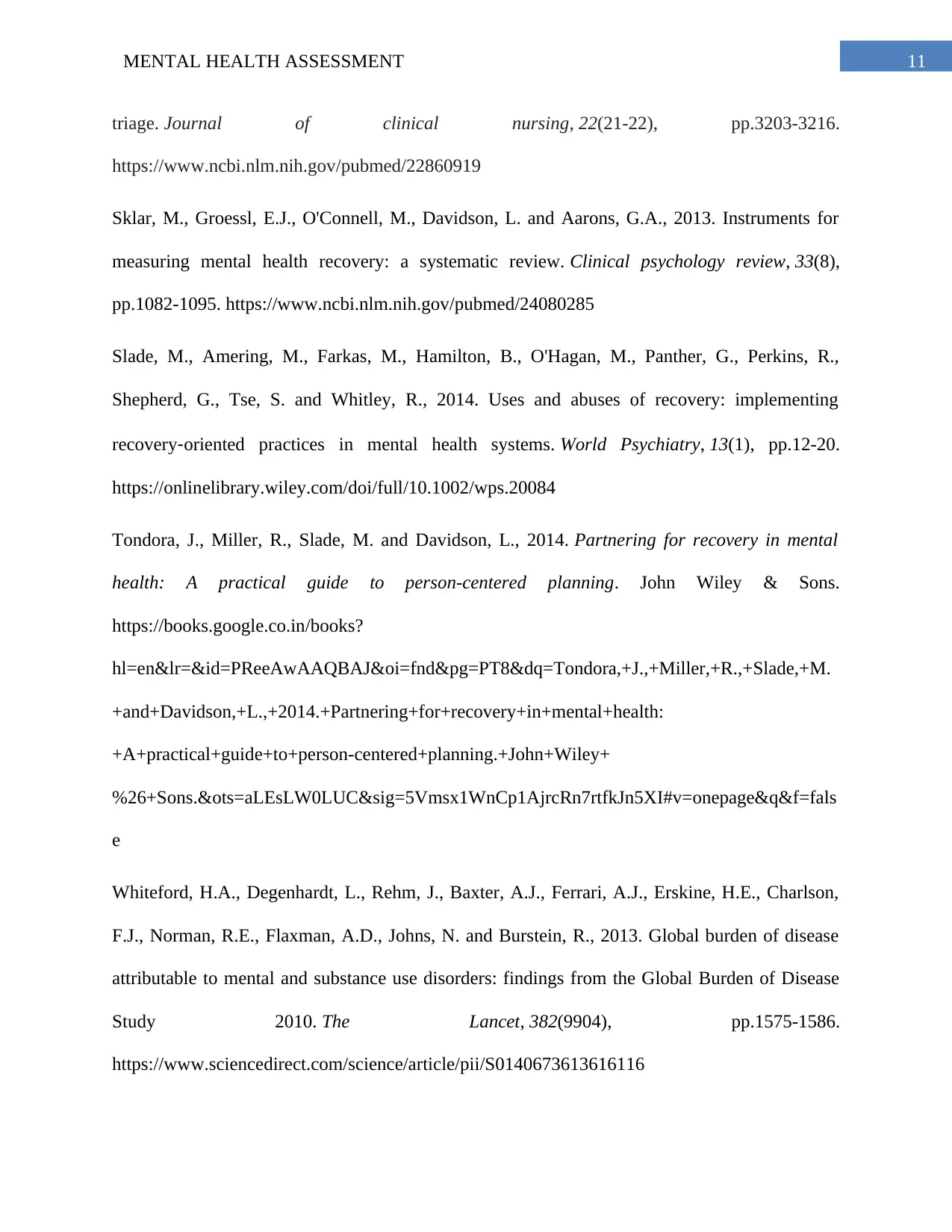
11MENTAL HEALTH ASSESSMENT
triage. Journal of clinical nursing, 22(21-22), pp.3203-3216.
https://www.ncbi.nlm.nih.gov/pubmed/22860919
Sklar, M., Groessl, E.J., O'Connell, M., Davidson, L. and Aarons, G.A., 2013. Instruments for
measuring mental health recovery: a systematic review. Clinical psychology review, 33(8),
pp.1082-1095. https://www.ncbi.nlm.nih.gov/pubmed/24080285
Slade, M., Amering, M., Farkas, M., Hamilton, B., O'Hagan, M., Panther, G., Perkins, R.,
Shepherd, G., Tse, S. and Whitley, R., 2014. Uses and abuses of recovery: implementing
recovery‐oriented practices in mental health systems. World Psychiatry, 13(1), pp.12-20.
https://onlinelibrary.wiley.com/doi/full/10.1002/wps.20084
Tondora, J., Miller, R., Slade, M. and Davidson, L., 2014. Partnering for recovery in mental
health: A practical guide to person-centered planning. John Wiley & Sons.
https://books.google.co.in/books?
hl=en&lr=&id=PReeAwAAQBAJ&oi=fnd&pg=PT8&dq=Tondora,+J.,+Miller,+R.,+Slade,+M.
+and+Davidson,+L.,+2014.+Partnering+for+recovery+in+mental+health:
+A+practical+guide+to+person-centered+planning.+John+Wiley+
%26+Sons.&ots=aLEsLW0LUC&sig=5Vmsx1WnCp1AjrcRn7rtfkJn5XI#v=onepage&q&f=fals
e
Whiteford, H.A., Degenhardt, L., Rehm, J., Baxter, A.J., Ferrari, A.J., Erskine, H.E., Charlson,
F.J., Norman, R.E., Flaxman, A.D., Johns, N. and Burstein, R., 2013. Global burden of disease
attributable to mental and substance use disorders: findings from the Global Burden of Disease
Study 2010. The Lancet, 382(9904), pp.1575-1586.
https://www.sciencedirect.com/science/article/pii/S0140673613616116
triage. Journal of clinical nursing, 22(21-22), pp.3203-3216.
https://www.ncbi.nlm.nih.gov/pubmed/22860919
Sklar, M., Groessl, E.J., O'Connell, M., Davidson, L. and Aarons, G.A., 2013. Instruments for
measuring mental health recovery: a systematic review. Clinical psychology review, 33(8),
pp.1082-1095. https://www.ncbi.nlm.nih.gov/pubmed/24080285
Slade, M., Amering, M., Farkas, M., Hamilton, B., O'Hagan, M., Panther, G., Perkins, R.,
Shepherd, G., Tse, S. and Whitley, R., 2014. Uses and abuses of recovery: implementing
recovery‐oriented practices in mental health systems. World Psychiatry, 13(1), pp.12-20.
https://onlinelibrary.wiley.com/doi/full/10.1002/wps.20084
Tondora, J., Miller, R., Slade, M. and Davidson, L., 2014. Partnering for recovery in mental
health: A practical guide to person-centered planning. John Wiley & Sons.
https://books.google.co.in/books?
hl=en&lr=&id=PReeAwAAQBAJ&oi=fnd&pg=PT8&dq=Tondora,+J.,+Miller,+R.,+Slade,+M.
+and+Davidson,+L.,+2014.+Partnering+for+recovery+in+mental+health:
+A+practical+guide+to+person-centered+planning.+John+Wiley+
%26+Sons.&ots=aLEsLW0LUC&sig=5Vmsx1WnCp1AjrcRn7rtfkJn5XI#v=onepage&q&f=fals
e
Whiteford, H.A., Degenhardt, L., Rehm, J., Baxter, A.J., Ferrari, A.J., Erskine, H.E., Charlson,
F.J., Norman, R.E., Flaxman, A.D., Johns, N. and Burstein, R., 2013. Global burden of disease
attributable to mental and substance use disorders: findings from the Global Burden of Disease
Study 2010. The Lancet, 382(9904), pp.1575-1586.
https://www.sciencedirect.com/science/article/pii/S0140673613616116
⊘ This is a preview!⊘
Do you want full access?
Subscribe today to unlock all pages.

Trusted by 1+ million students worldwide
1 out of 13
Related Documents
Your All-in-One AI-Powered Toolkit for Academic Success.
+13062052269
info@desklib.com
Available 24*7 on WhatsApp / Email
![[object Object]](/_next/static/media/star-bottom.7253800d.svg)
Unlock your academic potential
Copyright © 2020–2025 A2Z Services. All Rights Reserved. Developed and managed by ZUCOL.




